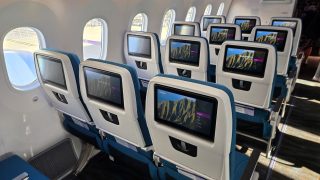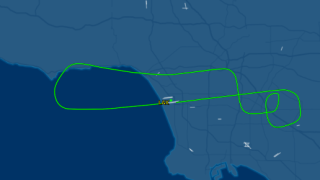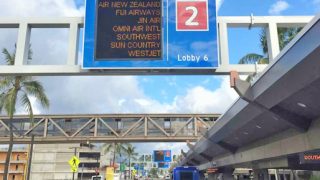Yesterday, Hawaiian Airlines had a frightening diversion that thankfully ended well. Flight 10 departed normally from Honolulu en route to Los Angeles. But within moments of take-off from the iconic Honolulu Airport Reef Runway, a serious problem occurred.
You’ll recall that Hawaiian Airlines recently had another diversion, that took place on July 22 from San Diego to Maui. That was in a recent run of 7 Hawaii diversions across three airlines.
Aborted climb-out, crew oxygen masks, and fast return to Honolulu.
The A330-200 wide-body climbed quickly to 6,500 feet, then told Air Traffic Control that there were fumes on board and a bad oily smell. The crew utilized oxygen masks for the return, which is normal procedure for such an incident. The emergency return to Honolulu took less than 20 additional minutes. They may or may not have dumped fuel prior to landing. Our understanding is that the fuel dump system was an option on the A330.
The A330 is configured to seat up to 278 passengers. We don’t know how many were aboard yesterday’s flight, however.
After returning to Honolulu a replacement aircraft was summoned, which is easy for Hawaiian to do at their home base in Honolulu. The next flight was uneventful and arrived in Los Angeles over five hours later than passengers expected.
Fumes in aircraft events.
This is always a big concern because of the possibly unknown causes and the potential for toxicity. Events with fumes in aircraft cockpits and passenger cabins can in worst cases result in nausea, dizziness and disorientation. When such events occur, smell type and intensity is quickly evaluated.
In 2014, a UAL Express pilot said he became nauseated and dizzy and “couldn’t think straight.” He said he could barely fly the plane after inhaling something noxious in the cockpit. “At the end of the day, we couldn’t even put a sentence together.”
The first thing pilots due when smelling excessive fumes is to don oxygen masks. Those masks either include or are augmented when necessary by their protective anti-smoke goggles. Pilots have told us, however, that these masks and goggles can reduce their vision and interfere with necessary conversation. There is, of course, a complete checklist that is performed in such an event, which is followed by remediation attempts.
However, when like yesterday’s flight, the plane is near a safe point of landing, or if the smell doesn’t subside after diagnosing and attempting to fix the problem, that is frequently the best option. Hawaii flights, which can include hours to the nearest stopping point always dictate maximum caution, such as was practiced in this incident.
See: Hawaii Has the World’s Longest Over-Water Flights (without diversion points).
Each year hundreds of fume-in-aircraft events occur, with some requiring medical attention. It is less frequent for pilots to use oxygen masks, but perhaps close to 25% of these events indicate that practice, according to an LA Times article.
The national library of medicine said, “The origin of the fumes in most cases was organic petroleum derivatives, which caused a multitude of symptoms including CNS dysfunction and mucous membrane irritation.”
We aren’t qualified to comment on all of the potential causes of fumes in the aircraft. It can be caused by a variety of things including contaminated air from the engines that may be caused by faulty oil seals. Keep in mind, however, that fumes in the cabin incidents are thankfully relatively rare in relation to millions of flights.
Get Breaking Hawaii Travel News







Hi BOH:
I track the HA 81/82 flight (HNL to/from AUS) often as much of my family lives in Austin and comes to visit us in Honolulu. Did you happen to notice that HA 81 (AUS-HNL) diverted to PHX yesterday at 11:00 MST and didn’t leave until 1:26 AM MST today, arriving in HNL 4:30 AM HST today? It left me pondering what the diversion could have been for.
Aloha,
Will
Hi Will.
Thanks so much for the tip. We appreciate it.
Aloha.
It would be interesting to know if the fumes were confined to the cockpit, and if not, if the passengers also had access to oxygen masks. I imagine it would be terrifying for the passengers. Maybe somebody on the plane will comment on this thread.
I was on a Hawaiian flight a few years ago, flying back to Honolulu from Oakland, California. We had smoke in our cabin and did not deploy oxygen to us but to crew members. Fear was flames might break out with added oxygen but crew members needed to alert and emergency land the plane. We exited via shoots. A few bumps and bruises. But all in all a successful landing. Seems an oil seal broke and oil leaking on hot brake lines. Fortunately, smoke but no fire.
The crew oxygen system is a completely separate and different system than the passenger oxygen masks that deploy from the overhead passenger service unit. The crew oxygen (think pilot and co-pilot) oxygen is provided by an oxygen cylinder located in an equipment bay underneath the cabin compartment that can contain up to 2000 PSI of aviators oxygen.
The passenger masks that drop from the overhead only produce oxygen via a chemical reaction when the masks are pulled down and a canister in the passenger service unit is activated. In the event of smoke in the cabin, those masks would do nothing which is why the flight crew has the type of oxygen system they have as well as smoke hoods